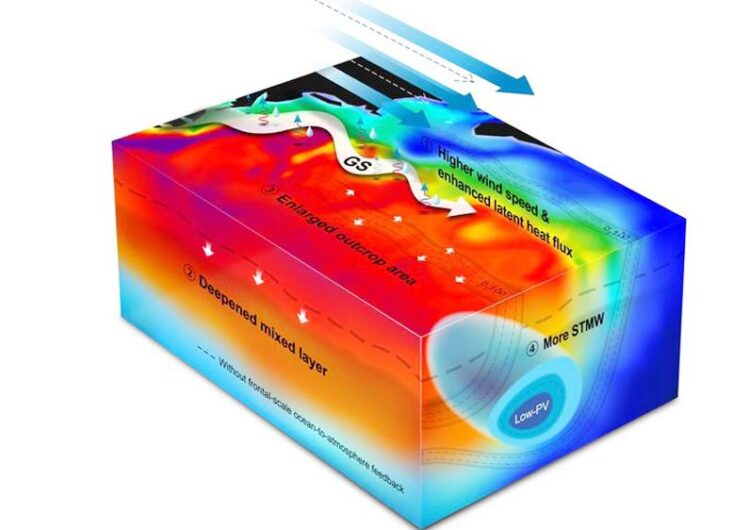Gulf Stream thermal fronts controlling North Atlantic subtropical mode water formation

The Gulf Stream thermal front leads to excessive ocean latent heat release primarily due to higher surface wind speed and sharper air-sea humidity contrast over its warm flank. The cumulative extensive latent heat loss favors the deepening of mixed layer, which gives rise to enlargement in the outcropping of corresponding isopycnals, leading to considerable transformation of lighter water masses into STMW.
Credit: ©Science China Press
Subtropical mode water (STMW) is a vertically homogeneous thermocline water mass, serving as heat, carbon, and oxygen silos in the ocean interior and providing memory of climate variability for climate prediction.
Understanding physics governing STMW formation is thus of broad scientific significance and has received much attention. Traditionally, it has been considered that STMW is constructed by basin-scale atmospheric forcing. Due to the limitations resulting from sparse sampling of observations and coarse resolution of climate models, less knowledge is acquired about the role of oceanic thermal fronts in the STMW production.
With focus on the North Atlantic Ocean where contains the thickest and volumetrically largest STMW in the global ocean, the team found for the first time that the feedback of sharp surface thermal fronts shaped by the Gulf Stream to the overlying atmosphere is essential for the STMW formation. By comparing twin simulations conducted with a state-of-the-art eddy-resolving coupled global climate model, it is found that suppressing local frontal-scale ocean-to-atmosphere (FOA) feedback leads to STMW formation being reduced almost by half. This is attributable to a vast increase in surface outcropping associated with the cumulative excessive latent heat release primarily due to higher wind speeds and greater air-sea humidity contrast driven by the Gulf Stream fronts (Figure 1).
Furthermore, the crucial role of the FOA feedback is attested by a multi-model and multi-resolution ensemble of latest global coupled models participating in CMIP6, in which with finer model resolution, the observed STMW is better reproduced due to more realistic representation of FOA feedback (Figure 2). “This is an important finding that incorporates the missing piece for the accurate STMW modelling and provides an effective solution to the common severe underestimation of STMW in earth system models” Dr. Gan says.
“This study lasted over 2 years since 2020 and I really enjoyed being part of it. It is a new exciting result that highlights the importance of frontal-scale air-sea interactions in climate system.” Dr. Yu says.
See the article:
Journal: National Science Review
North Atlantic subtropical mode water formation controlled by Gulf Stream fronts
All latest news from the category: Physics and Astronomy
This area deals with the fundamental laws and building blocks of nature and how they interact, the properties and the behavior of matter, and research into space and time and their structures.
innovations-report provides in-depth reports and articles on subjects such as astrophysics, laser technologies, nuclear, quantum, particle and solid-state physics, nanotechnologies, planetary research and findings (Mars, Venus) and developments related to the Hubble Telescope.
Newest articles

Innovative 3D printed scaffolds offer new hope for bone healing
Researchers at the Institute for Bioengineering of Catalonia have developed novel 3D printed PLA-CaP scaffolds that promote blood vessel formation, ensuring better healing and regeneration of bone tissue. Bone is…

The surprising role of gut infection in Alzheimer’s disease
ASU- and Banner Alzheimer’s Institute-led study implicates link between a common virus and the disease, which travels from the gut to the brain and may be a target for antiviral…

Molecular gardening: New enzymes discovered for protein modification pruning
How deubiquitinases USP53 and USP54 cleave long polyubiquitin chains and how the former is linked to liver disease in children. Deubiquitinases (DUBs) are enzymes used by cells to trim protein…


